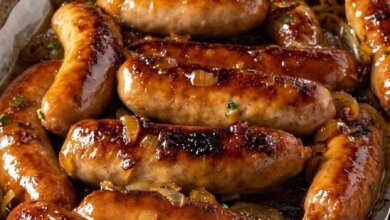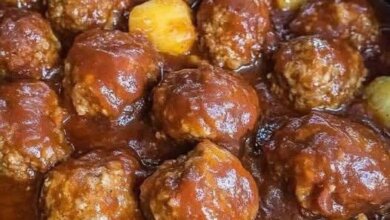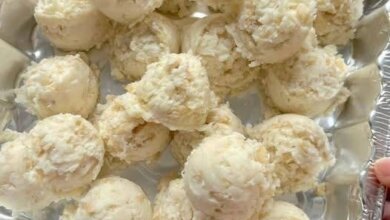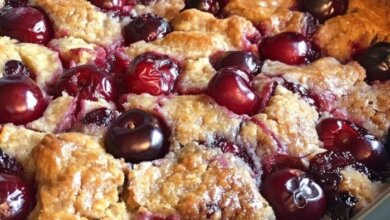Grandma’s Pie Crust Recipe

Grandma’s Pie Crust Recipe
Introduction
There’s nothing quite like a homemade pie, and the secret to a perfect pie lies in its crust. Grandma’s Pie Crust Recipe has been cherished through generations for its flaky, buttery layers and deliciously tender texture. This versatile crust can be used for both sweet and savory pies, making it a staple in any kitchen. Whether you’re crafting a classic apple pie or a rich chicken pot pie, this recipe promises to deliver a crust that complements any filling beautifully.
Ingredients
- Pastry flour: 3 cups
- Shortening: 1/2 cup
- Cold butter: 1/2 cup, cubed
- Ice-cold water: 1/2 cup
- White vinegar: 1 tablespoon
- Salt: 1 teaspoon
Instructions
1. Putting Together the Dry Ingredients
In a large mixing bowl, sift the pastry flour and combine it with the salt. This step ensures a uniform mixture and contributes to a lighter crust.
2. Cutting the Fats into the Mixture
Add the cubed cold butter and shortening to the flour mixture. Using a pastry cutter or your fingers, blend until the mixture resembles coarse crumbs. Keeping the fats cold is crucial for achieving a flaky texture.
3. Adding Huge Quantities of Liquid
In a small bowl, mix the ice-cold water and vinegar. Gradually add this mixture to the flour and fat mixture, using a fork to bring the dough together. Be careful not to overmix; you want just enough moisture to form a ball of dough.
4. Dividing and Rolling Out
Divide the dough into two equal portions. On a floured surface, roll out one half of the pastry to about 1/8 inch thick and slightly larger than your pie dish. Carefully place the rolled-out pastry into the dish, allowing the edges to hang over the sides.
5. Putting the Pie Together
For a single-crust pie, trim the excess dough from the edges and crimp as desired. For a double-crust pie, roll out the second half of the dough and position it over the filled pie. Cut slits in the top crust to allow steam to escape, and seal the edges by pinching or using a fork.
6. Baking
Bake the pie according to your filling’s recipe, generally at a temperature of 375-400°F (190-200°C) for 30-45 minutes, or until the crust is golden brown.
Serving and Storage Tips
Serving
Allow the pie to cool for at least 30 minutes before slicing. Serve warm, topped with a scoop of ice cream for dessert pies or enjoy savory pies as is.
Storage
Unbaked pie dough can be refrigerated for up to 2 days if wrapped tightly in plastic. Alternatively, it can be frozen for up to 4 weeks; just remember to thaw it overnight in the refrigerator before use.
Tips for Success
- Keep Everything Cold: For the flakiest crust, ensure your butter and shortening are very cold. You can even chill your mixing bowl and flour beforehand.
- Don’t Overwork the Dough: Overmixing can lead to tough crusts. Mix just until the ingredients come together.
- Roll Carefully: When rolling out the dough, start from the center and roll outward to prevent sticking. Use minimal flour to keep the dough from becoming too dry.
History
Pie crusts have a long and rich history, dating back to ancient times when they were used as a way to preserve food. Traditionally, crusts were made from simple ingredients like flour and water, serving as containers for meat and fruit. Over the centuries, as baking techniques and ingredients evolved, so did the art of pie-making, with each culture developing its own variations. Grandma’s recipe reflects this heritage, combining classic techniques with the comfort of home.
Benefits
Making your own pie crust has several advantages:
- Freshness: Homemade crusts are always fresher than store-bought options.
- Control Over Ingredients: You can choose high-quality ingredients and avoid preservatives.
- Versatility: This basic recipe can be adapted for various sweet and savory pies.
- Cost-Effective: Making your own pie crust can be more economical than purchasing pre-made varieties.
Nutrition
While traditional pie crusts are often viewed as indulgent, they can be part of a balanced diet when enjoyed in moderation. The key ingredients in this recipe provide essential nutrients:
- Flour: A source of carbohydrates for energy.
- Butter: Contains fat-soluble vitamins, such as A and E, and contributes to the crust’s rich flavor.
- Vinegar: Enhances the dough’s tenderness and can aid digestion.
Conclusion
Grandma’s Pie Crust Recipe is a timeless classic that guarantees flaky, delicious results every time. With simple ingredients and straightforward methods, you can create a crust that elevates any pie, from fruity desserts to hearty meals.
Whether you’re a novice baker or a seasoned pro, this recipe is a must-have in your culinary repertoire. With each bite of your homemade pie, you’ll taste the love and tradition passed down through generations. Embrace the art of pie-making and create delightful memories in the kitchen. Happy baking!



